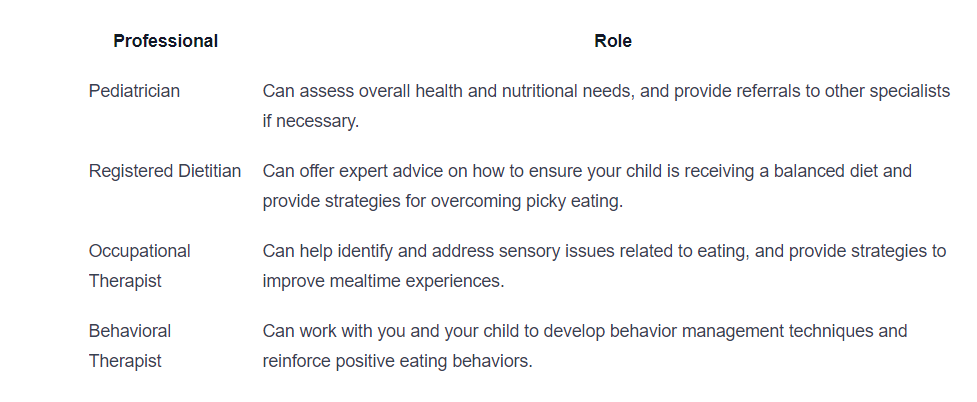How to Help Your Child with Autism Overcome Picky Eating
Supporting your autistic child with picky eating? Discover strategies, empathy, and patience to help them thrive. Overcome picky eating with compassion!

Understanding Picky Eating in Autistic Children
When it comes to picky eating in autistic children, it's important for parents to have a comprehensive understanding of this common challenge. By gaining insight into the link between autism and picky eating, identifying contributing factors, and embracing empathy and patience, parents can better support their child's dietary needs.

The Link Between Autism and Picky Eating
Picky eating is often more prevalent in children with autism compared to their neurotypical peers. The sensory and behavioral differences associated with autism can significantly impact a child's relationship with food. Autistic children may exhibit heightened sensitivity to tastes, textures, and smells, making it challenging for them to explore and accept a wide range of foods.
Factors Contributing to Picky Eating in Autistic Children
Several factors contribute to picky eating in autistic children, and it is essential for parents to be aware of them. Some of these factors include:
- Sensory sensitivities: Autistic children may experience heightened sensory sensitivities, which can make certain food textures or flavors overwhelming or aversive.
- Routine and predictability: Many autistic children thrive on routine and predictability. Changes in food choices or mealtime routines can be distressing and lead to food refusal.
- Limited food repertoire: Autistic children may have a limited range of preferred foods or exhibit strong food preferences. They may be more comfortable eating familiar foods and resist trying new ones.
The Importance of Empathy and Patience
Empathy and patience are crucial when supporting autistic children with picky eating. Recognizing that picky eating is not a choice or a behavioral problem but rather a result of their unique sensory and cognitive processing can help parents approach mealtimes with understanding and compassion.
By showing empathy, parents can create a safe and non-judgmental environment that allows their child to explore and gradually expand their food choices. Patience is essential as it may take time for autistic children to become comfortable with new foods or textures. Pressuring or forcing them to eat may create anxiety and further reinforce their aversions.
Understanding the link between autism and picky eating, identifying contributing factors, and approaching mealtimes with empathy and patience are the foundational steps in supporting autistic children with their dietary needs. In the following sections, we will delve into strategies to create a supportive mealtime environment, introduce new foods gradually, and address sensory sensitivities to help parents navigate this journey.
Strategies for Supporting Autistic Children with Picky Eating
Supporting an autistic child with picky eating requires a thoughtful and patient approach. By implementing strategies that focus on creating a supportive mealtime environment, introducing new foods gradually, and building a routine and structure, parents can help their child develop a healthier relationship with food.
Creating a Supportive Mealtime Environment
Creating a supportive mealtime environment is essential for promoting positive eating experiences for autistic children. Here are some strategies to consider:
- Establish a calm and quiet atmosphere during meals to minimize sensory distractions.
- Use visual supports, such as visual schedules or choice boards, to provide structure and predictability.
- Offer food choices within a limited range to empower the child and encourage autonomy.
- Incorporate preferred foods alongside new or challenging foods to make the mealtime experience more comfortable.
- Avoid pressuring or forcing the child to eat, as this can create anxiety and negative associations with food.
Introducing New Foods Gradually
Introducing new foods gradually can help autistic children become more receptive to a wider variety of foods. Consider the following strategies:
- Start by introducing small amounts of new foods alongside familiar and preferred foods.
- Use food chaining techniques, where similar foods are introduced gradually to build familiarity and acceptance.
- Encourage the child to explore new foods through sensory play, such as touching, smelling, and tasting in a non-threatening manner.
- Celebrate small victories and provide positive reinforcement when the child shows willingness to try new foods.
Building a Routine and Structure
Establishing a routine and structure around mealtimes can provide autistic children with a sense of predictability and security. Here are some tips:
- Set consistent meal and snack times to establish a routine.
- Use visual schedules or timers to help the child understand when it's time to eat.
- Create a structured mealtime routine that includes specific steps, such as washing hands, setting the table, and sitting down together.
- Offer clear and concise instructions during mealtime to help the child understand expectations.
By implementing these strategies, parents can create a supportive environment that encourages autistic children to expand their food preferences and overcome picky eating habits. It's important to remember that every child is unique, and what works for one may not work for another. Patience, empathy, and understanding are key in supporting the journey towards a healthier and more varied diet.
Implementing Positive Reinforcement
When it comes to supporting autistic children with picky eating, implementing positive reinforcement techniques can be incredibly helpful in promoting progress and creating a positive mealtime environment. In this section, we will explore three strategies: celebrating small victories, using visual supports and social stories, and seeking professional support.
Celebrating Small Victories
One effective way to encourage positive eating behaviors in autistic children is by celebrating small victories. By recognizing and rewarding their efforts, you can motivate them to explore new foods and expand their dietary repertoire. It's important to focus on the process and effort rather than the outcome. Here are some ideas for celebrating small victories:
- Verbal praise: Offering verbal encouragement and acknowledging your child's progress can boost their confidence and make them feel proud of their accomplishments.
- Sticker charts: Implementing a sticker chart can provide a visual representation of their achievements. Each time they try a new food or demonstrate positive eating behaviors, they can earn a sticker, working toward a predetermined reward.
- Special privileges: Granting small privileges or rewards, such as extra playtime or a favorite activity, can serve as a positive reinforcement for their efforts.
Using Visual Supports and Social Stories
Visual supports and social stories are powerful tools to help autistic children understand and navigate the world around them, including mealtimes. These visual aids provide structure, predictability, and clarity, which can help reduce anxiety and increase their willingness to try new foods. Here are some ways to utilize visual supports and social stories:
- Visual schedules: Create a visual schedule that outlines the steps of mealtime, from preparation to clean-up. This can help your child understand the routine and anticipate what to expect.
- Visual food choices: Use pictures or drawings to represent different food options. Displaying these visuals can help your child make choices and feel more in control of their meal.
- Social stories: Develop social stories that explain the importance of trying new foods, the benefits of a balanced diet, and the positive experiences they may have when expanding their food preferences.
Seeking Professional Support
Sometimes, supporting an autistic child with picky eating may require the guidance of professionals who specialize in autism and nutrition. Seeking professional support can provide valuable insights, personalized strategies, and a comprehensive approach to addressing the challenges of picky eating. Here are some professionals who can offer assistance:

Collaborating with professionals can provide additional support and resources to help your child overcome picky eating. They can tailor their guidance to your child's specific needs and offer personalized strategies for success.
By implementing positive reinforcement techniques, utilizing visual supports and social stories, and seeking professional support, you can create a supportive environment that encourages your autistic child to explore new foods and develop healthier eating habits. Remember to be patient, understanding, and celebrate each step forward, no matter how small it may seem.
Managing Sensory Sensitivities
Children with autism often experience sensory sensitivities, which can significantly impact their eating habits. Understanding and addressing these sensitivities is crucial in supporting autistic children with picky eating. Here are some strategies for managing sensory sensitivities:
Recognizing Sensory Sensitivities
Recognizing sensory sensitivities in autistic children is an essential first step in helping them overcome picky eating. Sensory sensitivities can manifest in various ways, such as sensitivity to certain tastes, textures, smells, or visual presentations of food. Paying attention to your child's reactions during mealtime can provide valuable insights into their sensory sensitivities.

Modifying Food Textures and Presentation
Modifying food textures and presentation can help accommodate sensory sensitivities and make mealtimes more enjoyable for autistic children. Here are some techniques to consider:
- Texture Modification: Altering the texture of foods can make them more palatable for children with texture sensitivities. For example, blending or pureeing foods to create smoother or softer textures.
- Food Presentation: Presenting food in a visually appealing manner can help overcome visual sensitivities. Experiment with different ways of arranging and presenting foods to make them more appealing to your child.
Providing Sensory Breaks
When sensory sensitivities become overwhelming during mealtime, providing sensory breaks can help your child regulate their sensory experiences and reduce stress. These breaks can involve engaging in calming activities that help them refocus before returning to the meal. Examples of sensory breaks include deep breathing exercises, engaging in a favorite sensory activity, or taking a short break in a quiet space.
By recognizing sensory sensitivities, modifying food textures and presentations, and providing sensory breaks, you can create a more comfortable and enjoyable eating environment for your autistic child. These strategies can help reduce mealtime stress and increase the chances of successful food exploration and acceptance. Remember, each child is unique, so it's essential to tailor these strategies to meet your child's specific needs.
Promoting Nutritional Balance
Ensuring a balanced diet is essential for the overall health and well-being of children, including those with autism who experience picky eating. By incorporating preferred foods into balanced meals, exploring alternative nutritional sources, and seeking consultation with a registered dietitian, parents can promote nutritional balance in their autistic child's diet.
Incorporating Preferred Foods into Balanced Meals
When supporting an autistic child with picky eating, it's important to acknowledge and respect their food preferences. Incorporating preferred foods into balanced meals can help ensure that they receive essential nutrients while gradually expanding their food repertoire. By combining familiar foods with new, nutritious options, parents can create a more varied and balanced diet.

Parents can complement preferred foods with nutrient-rich side dishes and additions. For example, serving chicken nuggets with steamed vegetables or yogurt with fresh fruits can enhance the nutritional value of the meal. Slowly introducing new foods alongside familiar ones can help children become more comfortable with dietary variety.
Exploring Alternative Nutritional Sources
In some cases, autistic children with picky eating habits may have specific nutritional deficiencies due to limited food choices. Exploring alternative nutritional sources can help address these gaps and ensure adequate nutrient intake. Here are some examples:

By incorporating these alternative sources of nutrients into the child's diet, parents can provide them with the necessary vitamins, minerals, and essential fatty acids that may be lacking.
Consultation with a Registered Dietitian
Seeking guidance from a registered dietitian who specializes in working with children with autism can be immensely beneficial. A dietitian can assess the nutritional needs of the child, provide personalized recommendations, and help develop strategies to overcome picky eating habits.
Working together with a registered dietitian, parents can create a tailored meal plan for their autistic child that takes into account their preferences, nutritional requirements, and any specific dietary restrictions. This professional support can provide valuable insights, reassurance, and practical strategies for promoting nutritional balance in the child's diet.
By incorporating preferred foods into balanced meals, exploring alternative nutritional sources, and seeking consultation with a registered dietitian, parents can support their autistic child in developing a more varied and nutritious diet. It's important to remember that progress takes time, and patience is key on this journey toward a healthier and more balanced approach to eating.
Encouraging Self-Advocacy and Independence
Supporting an autistic child with picky eating involves empowering them to develop self-advocacy skills, make independent decisions, and build confidence. By fostering their communication and decision-making abilities, allowing autonomy in food choices, and promoting resilience, parents can help their child overcome picky eating challenges.
Teaching Communication and Decision-Making Skills
One effective way to encourage self-advocacy and independence is by teaching communication and decision-making skills to your child. This can involve using visual aids, such as picture cards or visual schedules, to help them express their preferences and make choices about their meals.
Strategies for Teaching Communication and Decision-Making Skills
Use visual aids, such as picture cards or visual schedules, to support communication and decision-making.
Encourage your child to verbalize their preferences and opinions about food.
Practice role-playing scenarios to help your child develop assertiveness and self-expression skills.
Allowing Autonomy in Food Choices
Granting autonomy in food choices can be empowering for autistic children with picky eating. Giving them a sense of control over their meals can help reduce anxiety and resistance during mealtimes. Provide a variety of food options and allow your child to choose what they want to eat from the available choices.
Tips for Allowing Autonomy in Food Choices
Offer a range of food options to choose from, including familiar and preferred foods.
Let your child participate in meal planning or grocery shopping to encourage engagement and involvement.
Respect their choices, even if they prefer repetitive or limited food selections.
Building Confidence and Resilience
Building confidence and resilience is crucial for autistic children with picky eating. By creating a supportive environment and celebrating small victories, parents can help their child develop a positive relationship with food and overcome challenges.
Strategies for Building Confidence and Resilience
Celebrate small achievements and progress made in trying new foods or expanding food preferences.
Provide positive reinforcement and encouragement during mealtimes.
Foster a non-judgmental and patient atmosphere to reduce stress and anxiety related to food.
Promoting self-advocacy and independence in autistic children with picky eating requires patience and understanding. By equipping them with communication and decision-making skills, allowing autonomy in food choices, and supporting their confidence and resilience, parents can help their child develop a healthier relationship with food and expand their dietary repertoire.
Sources
https://www.autismspeaks.org/expert-opinion/autism-and-food-aversions
https://www.autismparentingmagazine.com/how-to-help-your-asd-child-overcome-picky-eating-now/
https://childmind.org/article/autism-and-picky-eating/
Similar articles
We’re here to help you

Our team is here to assist you in this process. Contact us for any assistance.
it’s easy to apply
We Accept Most Insurances
Our in-network insurance partnerships make ABA therapy more accessible to families throughout our service areas.







Our Insurance Process
We'll request your insurance details to help us verify your plan's coverage for ABA therapy. Once we've received this information, we'll walk you through your benefits, including copayments, deductibles and out-of-pocket maximums, so you know what to expect in advance.
Our team will then handle the preauthorization and all the necessary paperwork.
.svg)





















.jpeg)


































.jpeg)




.jpeg)







.jpeg)











.jpeg)
















